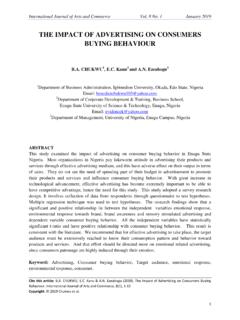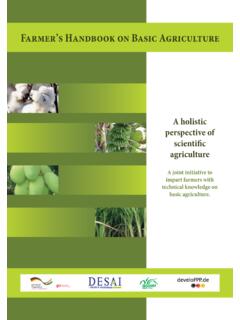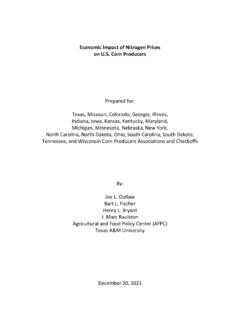Transcription of THE IMPACT OF INTERNATIONAL TRADE ON THE …
1 INTERNATIONAL Journal of Arts and Commerce ISSN 1929-7106 Cite this article: Bakir, H. (2019). The IMPACT of INTERNATIONAL TRADE on the economic growth of Developing Countries: An Empirical Study of Kenya. INTERNATIONAL Journal of Arts and Commerce, 8(7), 38-48. 38 THE IMPACT OF INTERNATIONAL TRADE ON THE economic growth OF DEVELOPING COUNTRIES: AN EMPIRICAL STUDY OF KENYA Assistant Professor Dr Hasan BAKIR Anadolu University, Eski ehir, 26470, Turkey Published: 22 August 2019 Copyright Bak r.
2 Abstract The link between TRADE and economic growth has been the subject of extensive and intensive exploration in the recent past, with several studies measuring different aspects of both. Most of these studies have been concentrated on the developed economies. However, interest has been growing lately to determine the effects of TRADE and openness on the economies of developing countries. The study applied the Cointegrated VAR (CVAR) approach with steps from ADF test to The Johansen co-integration test to Vector Error Correction Model (VECM) and finally to the VAR granger causality to determine the existence of long-run equilibrium co-integration and causality between INTERNATIONAL TRADE and the rate of economic growth .
3 The model included Exports, FDI and Inflation as the regressor variables of GDP and concluded that there is a significant and positive long-run relationship between export and growth with a bidirectional causality where GDP granger causes export, and export granger causes GDP. Key Words: Causality Test, Technology Spillover, Regression Analysis, VAR, TRADE Openness INTERNATIONAL Journal of Arts and Commerce Vol. 8 No. 7 August 2019 39 I. INTRODUCTION Many scholars consider INTERNATIONAL TRADE as one of the avenues for the third world economies to compete and come to economic parity with their developed counterparts.
4 Most developing nations are known to be in abundant possession of numerous natural resources that are in constant and growing demand in the world markets, but whether the TRADE in these resources is beneficial to them is not an issue of easy consensus. TRADE is an important factor in economic growth , and this is majorly achieved through exportation, importation and incorporation of advanced technological systems and innovations. INTERNATIONAL trade1 opens local firms to competition and hence the effort to incorporate more effective and efficient production systems (Belloumi, 2014).
5 The ability of TRADE to IMPACT the economic growth of any country is however dependent on the suitability of the environment and effectiveness of the application of the borrowed systems. Both endogenous and exogenous growth theories are in agreement that one of the ways through which TRADE may bring growth to developing countries is through knowledge and technology spillovers occasioned by the importation of capital and immediate products from the developed world. Utilizing this knowledge in imitation and innovation is likely to lead to improved efficiency in the production of the said developing country.
6 However, if the TRADE pattern is skewed by the comparative advantages such that the developing countries can only specialize in the traditional manufacturing or extraction sectors then no meaningful growth is likely to be derived from such TRADE as observed by Alfonso (2001) while trying analyze the dynamics of TRADE and technology on economic growth . The first and second world economies have more sophisticated and better-structured business systems that put them in a position to benefit enormously from any form of INTERNATIONAL TRADE , and some have achieved this at the expense of the developing countries.
7 Liberalism and openness of TRADE (free TRADE ) are some of the factors that have been touted to enhance the capacity of INTERNATIONAL TRADE ; but the existence of associated structural imbalances in the form of import- export, budget deficits and inflation has led to competition at the expense of the weaker economies creating a dependency situation hence widening the gap(Eneji, 2012). Jen ek&Krepl (2008) define foreign TRADE as a reflection of economic relationships among the individual economies and represents the part of the country foreign relationships, which include TRADE exchange of a part of the production .
8 They view INTERNATIONAL TRADE as a form of substitution of local (home) production systems and structure and home resources with imported products and borrowed technologies as well as foreign resources. They however contend that the ability of INTERNATIONAL TRADE to influence the economy of a country depends on the quality of its imports and the competitiveness of the products of the country in the INTERNATIONAL market. Free TRADE leads to efficient utilization of available resources thus leading to improved production through the effects of comparative advantage and according to geographical distribution of factors of production and specializationas observed by Hamideh (2012).
9 The results of this study are intended be contributory to the existing research and to bring insightful knowledge on the policies, trends and relationship that exists in a single state (as opposed to cross-country comparisons). Also, the results will be useful to policymakers as a means of achieving maximum exploitation from the country s TRADE activities. With this regard, the main objectives of this study are: 1 INTERNATIONAL TRADE is the main factor in TRADE openness and is considered by many scholars as in interchangeable term.
10 This paper also treats the two terms as synonyms. INTERNATIONAL Journal of Arts and Commerce ISSN 1929-7106 40 To identify if there is a cointegration between INTERNATIONAL TRADE and economic growth To determine whether INTERNATIONAL TRADE affects economic growth positively or negatively. This structure of this paper is organized that section II reviews empirical literature on TRADE and INTERNATIONAL growth , section III gives a profile of Kenya and a brief account of the transformations it has undergone with reference to TRADE (export and import policies).




